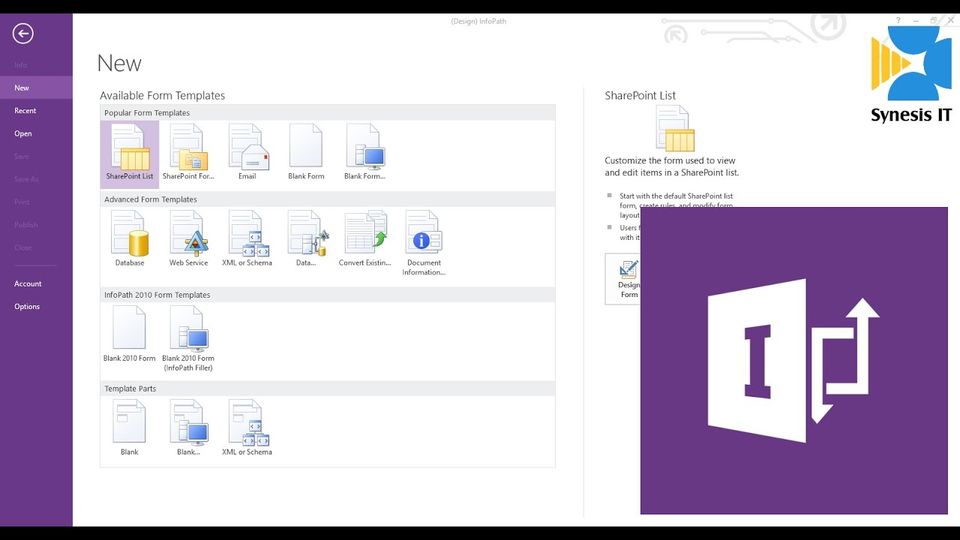Microsoft InfoPath Overview

InfoPath is a software designed for handling XML documents. Initially launched in 2003, it has undergone several updates, with the latest version released in 2013, representing a more modern iteration.
Table of contents
Functionality
InfoPath facilitates the gathering and processing of data essential for constructing interactive diagrams. The program seamlessly integrates with XML schemas and related services, enabling easy inclusion of vital information into various processes. Its utility is particularly significant in business settings, offering tools to streamline numerous operational procedures.
Concept

InfoPath forms operate on the principle of separating form templates from their data. A form template, identified by the .xsn extension, defines the structure and design of a form. On the other hand, form data is stored in XML files, providing the specific information that populates the form.
Microsoft Office InfoPath Features
Develop Forms with Ribbon Interface
The ribbon interface simplifies form development by organizing commands into tabs corresponding to specific tasks, facilitating quicker customization.
Work with Sharper Shapes using InfoPath Filler
InfoPath Filler provides an intuitive user interface for filling out forms, akin to working with documents. Forms can be saved locally and accessed offline, enhancing flexibility.
Utilize Client Capabilities
InfoPath offers robust text formatting, autocorrect, table and figure support, and spell checking, enhancing user experience and productivity.
Publish Forms
Forms can be published directly from the Ribbon Quick Access Toolbar or Microsoft Office Backstage View, serving as a centralized hub for form-related actions.
Create Forms for SharePoint Lists
Users can effortlessly design forms based on regular or external SharePoint lists with a simple click, automating form creation and customization.
Autonomous Form Filling
Available in Microsoft SharePoint Workspace, forms can be completed online or offline and seamlessly integrated with data from SharePoint lists, enhancing accessibility and usability.
Deploy Forms as Part of Automated Processes
SharePoint Server and SharePoint Designer enable the deployment of forms as part of automated processes, facilitating routing organization and notifications.
Development of Modular, Extensible, and Portable Solutions
InfoPath allows for the creation of modular, extensible, and portable solutions with minimal or no coding, enhancing workflow efficiency and flexibility.
Utilize Functional Web Forms
InfoPath web forms now offer many features previously exclusive to the client application, enhancing compatibility and accessibility across different browsers.
Manage Forms on the Server
New SharePoint servicing engine rules ensure correct configuration of InfoPath forms, with command-line shell and Windows PowerShell scripting language included for efficient form management.
Enhancing Form Functionality
Microsoft Office InfoPath facilitates the addition of code to forms, allowing for more robust data collection tailored to specific business processes. By utilizing Visual Studio Tools and straightforward publishing capabilities, users can enhance forms to interact seamlessly with various applications.
Integration with Business Systems
InfoPath supports integration with SharePoint Server Business Connectivity Services (BCS), which expands the functionalities of Office applications by enabling a seamless connection to business systems. This architecture assists in managing user access and data interactions effectively.
Web Services and Data Retrieval
InfoPath has adapted to modern web standards by supporting REST web services, enabling developers to retrieve XML data using URL parameters. This feature allows for dynamic adjustment of parameters without the need for coding, streamlining data retrieval processes.
Form Embedding and Interaction
With the introduction of the InfoPath Form web part in SharePoint Server, users can now easily embed forms onto web pages. These forms can interact with other web parts to send and receive data, enhancing user interaction on ASP.NET pages without complex coding.
Usage and Accessibility
InfoPath is designed for power users and developers to create complex electronic forms quickly and cost-effectively, supporting diverse organizational needs from departmental to enterprise-wide applications. It simplifies connections to necessary resources and information, enabling efficient and rapid data collection.
Operational Impact and Form Management
InfoPath significantly impacts operational efficiencies by allowing the creation of modular, expandable, and portable solutions that require minimal coding. It enables the publishing of forms in accessible locations for user interaction, supporting various subsequent actions like data submission or storage.
Conclusion
Overall, Microsoft Office InfoPath stands as a critical tool in enhancing organizational efficiency through advanced data collection, form management, and integration capabilities.
Article FAQ
- What is Microsoft InfoPath?
- Microsoft InfoPath is a software application designed to manage and process XML documents. It facilitates the creation of interactive forms and data collection, particularly useful in business settings.
- When was Microsoft InfoPath first launched?
- InfoPath was initially launched in 2003, with the latest version released in 2013.
- What is the main function of InfoPath?
- InfoPath's main function is to gather and process data, allowing users to create interactive forms that integrate with XML schemas and services, streamlining business processes.
- How does InfoPath separate form templates and data?
- InfoPath operates on the principle of separating form templates (.xsn) from form data (stored in XML files). The template defines the structure, while the data populates the form.
- What features does InfoPath offer for form development?
- InfoPath offers a ribbon interface for quick customization, InfoPath Filler for easy form completion, text formatting, autocorrect, spell-checking, table support, and direct form publishing options.
- Can InfoPath integrate with SharePoint?
- Yes, InfoPath can create forms for SharePoint lists, allowing users to design forms based on regular or external lists. Forms can also be part of automated processes in SharePoint.
- What are InfoPath's client capabilities?
- InfoPath supports robust client capabilities, including text formatting, autocorrect, table and figure support, and spell checking to enhance productivity.
- Can InfoPath forms be used offline?
- Yes, InfoPath forms can be saved and accessed offline, particularly through Microsoft SharePoint Workspace, allowing users to work with forms without an internet connection.
- How does InfoPath enhance workflow efficiency?
- InfoPath enhances workflow efficiency by allowing the creation of modular, extensible, and portable solutions with minimal or no coding, integrating with SharePoint for automated processes.
- How does InfoPath support web forms?
- InfoPath web forms include features previously only available in the client application, ensuring compatibility and accessibility across different browsers.
- Can InfoPath integrate with business systems?
- Yes, InfoPath integrates with SharePoint Server Business Connectivity Services (BCS) to enhance the connection between Office applications and business systems.
- What are InfoPath's capabilities for data retrieval?
- InfoPath supports REST web services, enabling developers to retrieve XML data dynamically using URL parameters, streamlining data retrieval without coding.
- What is the role of the InfoPath Form web part in SharePoint?
- The InfoPath Form web part allows users to embed forms on web pages, enabling interactions with other web parts and enhancing user interaction without complex coding.